Social History in Focus:
the 1718 Pew List
A volunteer-led research on the many names listed in the 1718 Pew List: an extraordinary cast of characters connected to the church, an invaluable piece of social history. Please come back regularly to this page to check for updates as we carry out more research and unfold more stories.
Visit us to discover more. We are placed at the heart of Maritime Greenwich World Heritage site and have welcomed visitors since the 1700s.
Free to visit, donations welcome.
A church should not be so fill’d with pews, but that the poor may have room enough to stand and sit in the alleys, for to them equally is the gospel preach’d. It were to be wish’d there were... no pews, but benches; but there is no stemming the tide of profit, and the advantage of pew-keepers...
Sir Christopher Wren, 1708
[Please scroll down for the cast of characters listed in the Pew List]
What is a pew list?
A pew list comprises a numbered list of groups of names, of varying sizes, and their pew allocation. Pew rental was a common practice and is found at least as early as 1409. It occurred fairly widely before the Reformation and became commonplace thereafter. However, the arising sense of entitlement to a particular place led to numerous disputes. As a result of such problems, pew renting came under attack in the 19th century.
Pew layouts
In 1718, the church designed by the architect Nicholas Hawksmoor, with its dramatic English baroque style, reopened its doors to the local community. Two alternative pew layouts, for 646 and 520 seats, were drawn and submitted to the Commissioners in May 1716. The larger number was accommodated by having many larger pews that would seat 13 people. With smaller pews, seating only 4, 5 or 6 people, fewer were accommodated. There appear to be no records of the original pews’ installation: the church was re-pewed in the nineteenth century. The layout drawings show only the ground floor and we do not know the capacity of the galleries where there were probably fewer pews for rent and a larger number of free benches.
The 1721 petition
In 1721 a petition was sent to the Commissioners for the erection of more pews in the cross aisle, so clearly the initial arrangement was considered inadequate. However, it is unlikely that the total capacity of the church would have approached the 2000 that Wren considered reasonable for an “auditory” church.
From 1500 to 1800
John Kimbell’s An account of the legacies, gifts, rents, fees & c. appertaining to the church and poor of the parish of St Alphege Greenwich, in the County of Kent, ..., published in 1816, states that there was accommodation for 1500 people, but that this was inadequate to the demand at the time. The large-scale Ordnance Survey map of 1876 records that the church had 1800 sittings.
The 1718 Pew List
St Alfege Church’s archive holds a document dated 29 September 1718 which lists, over 11 pages, the pew holders. The title of the document refers to a seating plan, but this has evidently been detached from the document and its location is unknown. Nevertheless, the list itself is of great interest, giving an insight into the social character of Greenwich parishioners at this date.
The need for a Pew List
The list is prefaced by the agreement of the Bishop of Rochester to the proposed pew layout. The agreement throws light on the organisation of the parish at the time, and on the importance of an agreed pew layout:
And Whereas the New Church being now duly Consecrated and opened for the use of the said Parishioners, it is highly fitting and reasonable that, upon their immediate Resort to it for the Daily Celebration of Divine Service, the said Parishioners should be informed in what seats they ought severally to sit and should accordingly repair to such seats, when they attend Divine Service, for the avoiding of Disorder and Confusion which must otherwise necessarily arise in so numerous an Assembly, composed of Persons of so different and unequal a Condition and Character.
Pews’ location
The pews are described as being located in four distinct areas: North Body, North Gallery, South Body and South Gallery. In the nave (or body) of the church the numbered pews are ordered from the Vicar at the front in pew no.1 to pew no. 36 at the back of the church. In the gallery the arrangement is less clear, but the lower numbered pews have fewer occupants, suggesting they were more prestigious and likely to be located at the front of the gallery.
The people
The 1718 Pew List includes 903 names in total, 430 of whom are women. There are many names with titles including Sir, Capt., General, Lady, Madam, Widow, Esq., Mr and Mrs, alongside those whose full name suffices. Most of the pews are occupied by either men or women, and families are separated as a result. The front 19 pews in the South Body and 14 pews in the North Body of the church are occupied by women only, with few exceptions. So, the front half of the nave pews were occupied mostly by women. The pew list suggests the church was densely occupied and the inhabitants were carefully arranged within the space.
The Gallery pews
The 53 Gallery pews are dominated by male names. Just 13 individual women’s names are listed for Gallery pews, although the ‘Charity Girles’ were allocated the West End North Gallery Room (now an enclosed meeting room).
Cast of characters
[Please bear in mind that this is a work-in-progress and contents are reviewed as new information is brought to attention. Please come back to this page as new contents will be added on a regular basis]
Moreton M.D.
Richard Morton MD (Doctor of Medicine, abbreviated M.D., from the Latin Medicinae Doctor). Appointed MD to Royal Hospital in Greenwich 18th April 1716. Died 1st February 1730. Buried in Plumstead. Family members: Fasby Morton (Wife), Fasby (daughter, baptised October 1724?), Mary (daughter, baptised St Alfege February 1725), Richard (son, baptised St Alfege 7th March 1726), Elizabeth (daughter, baptised St Alfege October 1728).
In 1718, you would find Richard Morton in the North body of the gallery.
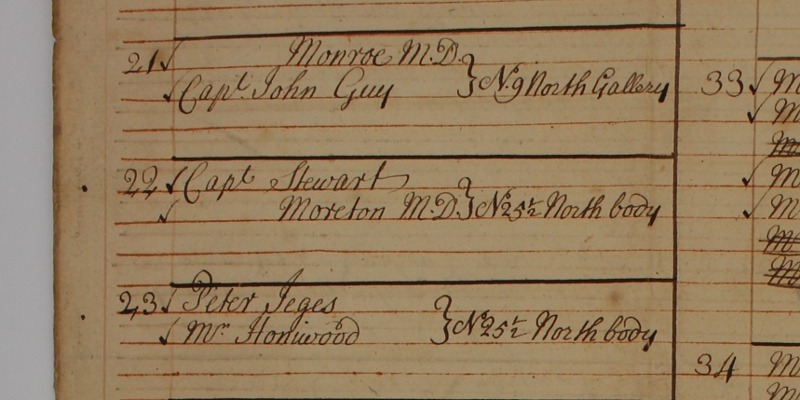
[Thanks to Andrea Bashford for sharing her research, knowledge and passion with us]
Mr George Moult
FRS Chymist (Chemist). Made a Fellow of the Royal Society in 1689. Died: 1727.
George Moult lived at Park Corner House (part of Montague House) it became known for a while as Moles (Moult) House and then known as Moles Corner on the John Roque map of 1746
Dr Nehemiah Grew was the founding scientist of Epsom Salts and how to extract purging salt (magnesium sulphate) from the water at Epsom which became forever known as Epsom Salts, he was granted a Royal Patent in 1698 and sold the salts through many outlets at 16 shillings a pound however George and his brother Francis discovered that they could also extract the salt from a well at Shooters Hill and despite Dr Grew having the patent they decided to sell their own Salts at 3d a pound thereby undercutting Grew by some considerable amount! In 1700 the Moults sold their salts at the Glaubers Head on Watling Street (Dr Glauber a German scientist, a sign often used by chemists) See image below. Dr Grew attempted to protect his invention and eventually the Moults were reprimanded by the Lord Chancellor. It seems that possibly Francis was the dodgy brother but George it seems was involved in this business.
In 1718, you would find George Moult in the North gallery.
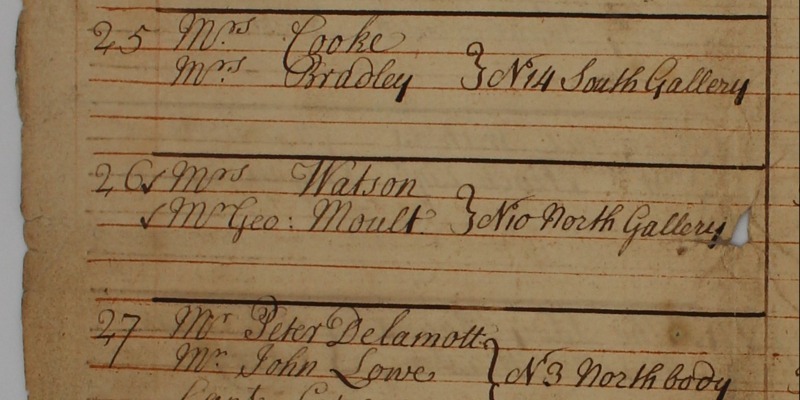
[Thanks to Andrea Bashford for sharing her research, knowledge and passion with us]
John Shish Esq.
John Shish Gent came from a long line of shipwrights, ship designers and builders who worked at Deptford, Woolwich and Sheerness. John Evelyn, in a diary entry, says that the family descended from 100 years of shipwrights. John Shish married Mary Miller in 1715. They married at St Margaret's Church in Lee as St Alfege was not finished. In 1729, when John Shish wrote his will, he was clearly quite wealthy. In the will he left his daughter £3,500 (almost £600,000 in today’s money!) which she was to inherit at the age of 15. John left the rest and residue of his estate to his son John Archer, which included properties in Surrey, Sussex and Barham Town. Of 6 children only 2 survived him.
His great grandfather, Jonas Shish, lived in Deptford from 1668 to 1675. He lived in the Shipwrights House at Deptford Dockyard (which still exists today). He was a well-known and much respected ship designer, builder and shipwright. He was greatly respected by Sir John Evelyn, who also resided in Deptford. Sir John Evelyn held one of the 4 palls over Jonas coffin at his funeral.
Jonas was disliked by Samuel Pepys. On the death of Christopher Pett, who had been master shipwright at Deptford & Woolwich, Jonas asked Pepys to put in a good word with King Charles II to succeed Pett at the Deptford Dockyard. When Pepys met the King, the decision had already been taken to make him Pett’s replacement at both shipyards.
He waited on Sir Christopher Wren and gave him an estimate for his sloop The Chatham.
He built the ship HMS Blenheim, formerly The Duchess, Princess Anne and the Windsor Castle, which is the ship painted on the ceiling in the Painted Hall at the Old Royal Naval College. All this by a man who, according to Sir John Evelyn, was almost illiterate!
There is a memorial in St Nicholas Church Deptford to Jonas Shish and some of his descendants.
In 1718, you would find John Shish Gent in the South gallery.
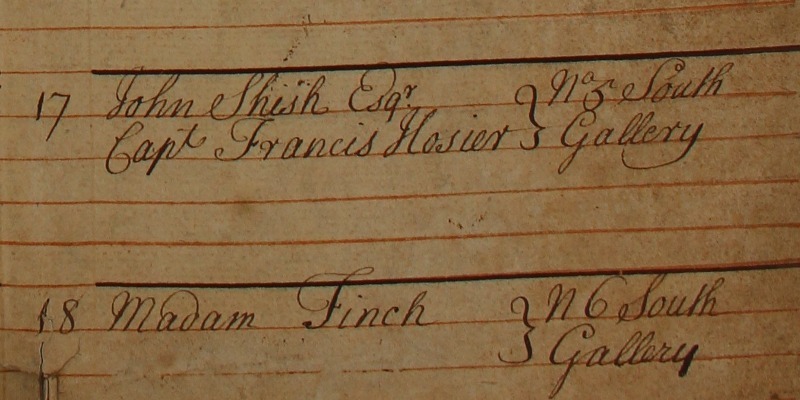
[Thanks to
Andrea Bashford for sharing her research, knowledge and passion with us]
The Everest Family
The Everest family have been in Greenwich from at least the mid-17th century. Before that they appear to have lived in Kent. Occasionally the family named is spelt Everist in documentation but more usually Everest, as in the wills of the Messers Everest Senior and Junior.
The Everists that appear in the 1718 Pew List seem to be the family of Tristram Everest Senior. He married Ann in St Luke’s Church, Charlton in 1657. Ann is the 'Mrs Everist Sen' that is in the Pew List. Tristram owned a butcher’s shop in Church Street, Greenwich. He also owned land and property in Kent as seen from his Will written in 1717. His son, Tristram Junior, was also a butcher in Greenwich, probably in the same premises in Church Street. He married Mary and this is 'Mrs Everist Jun' in the Pew List.
He left money in his Will to his eldest son, Charles, to carry on his trade, which was likely to be butchery. He left his property to his daughter Mary and her husband and also to his son John. The property was near Garden Stairs, Greenwich. The Garden Stairs were next to where the southern end of the foot tunnel is now.
Tristram’s son John was the first member of the family to enter the legal profession. He was apprenticed to William Bradley, an attorney. John is buried in St Alfege crypt. The Everests became a well-known family of solicitors in Greenwich. A later relative was a solicitor to Greenwich Hospital and was often in dispute with the Paris Clerks of St Alfege’s about poor rates.
Tristram junior’s great grandson was Sir George Everest. He was a surveyor and geographer who served as Surveyor General of India from 1830 to 1843. George Everest never saw Mount Everest, but he hired Andrew Scott Waugh who made the first formal observations of the mountain and it was he who proposed that the mountain be named after George Everest. Everest himself objected to his name being used and favoured an Indian name.
In 1718, you would find Tristram Everist Senior and Junior in the North Body of the church, while Mrs Everist Senior and Junior would sit in the South body.
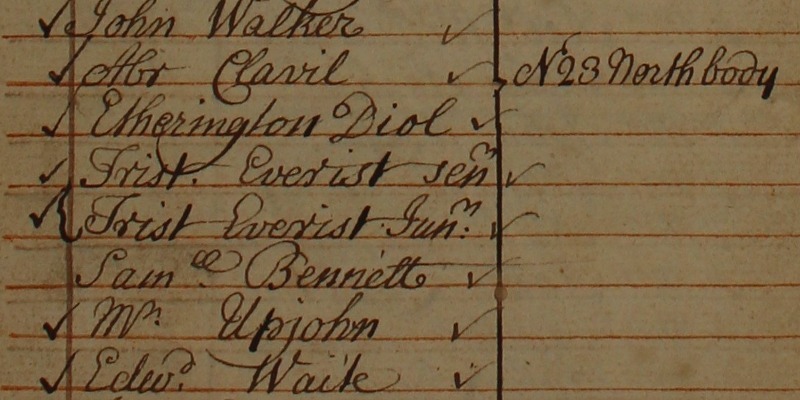
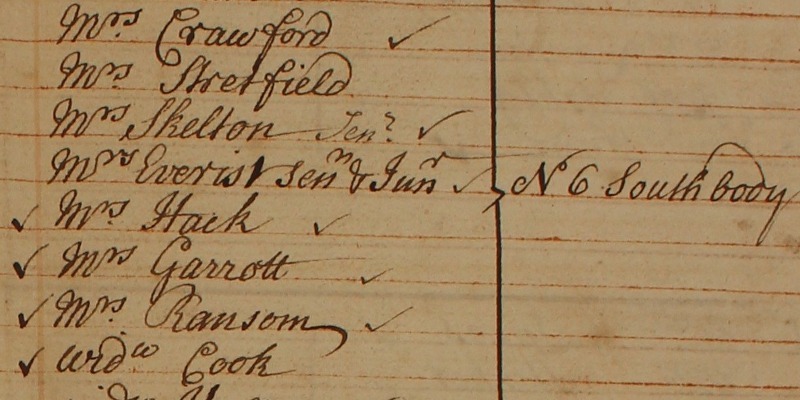
[Thanks to
Ann Foster for sharing her research, knowledge and passion with us]
*****
Pew List research references:
Old Parish Life. A guide for the curious, by Justin Lovill, The Bunbury Press, 2002
St Alfege Church Greenwich: Conservation Management Plan, by Richard Griffiths Architects, 2017
Greenwich Parish Church, Memorialisation and Community, c.1700 to present day, by Dr Alison Mary Fisher, 2020